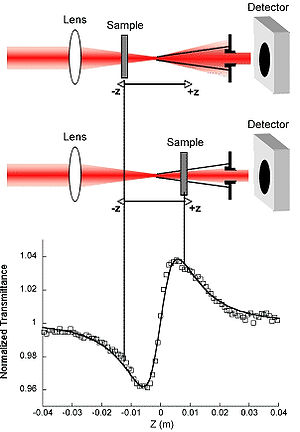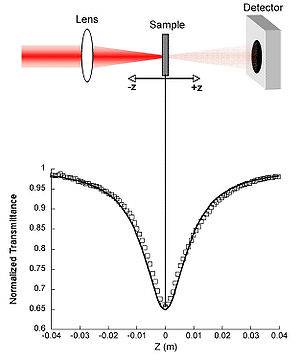Difference between revisions of "Femtosecond Z-Scan Spectrometer"
Cmditradmin (talk | contribs) m (→Significance) |
Cmditradmin (talk | contribs) m (→Significance) |
||
| Line 7: | Line 7: | ||
[[Image:Selffocus.jpg|thumb|300px|As a third order materials passes through an focused light beam its index of refraction changes causing a focusing or defocusing of the beam.]] | [[Image:Selffocus.jpg|thumb|300px|As a third order materials passes through an focused light beam its index of refraction changes causing a focusing or defocusing of the beam.]] | ||
The z-scan is based on the self-focusing effect. The index of refraction of a third order material changes as the intensity of the beam changes. As a sample through a focused beam the intensity of incident light increases to a point where the sample changes its index of refraction and alters the focus of the light which can be | The z-scan is based on the self-focusing effect. The index of refraction of a third order material changes as the intensity of the beam changes. As a sample through a focused beam the intensity of incident light increases to a point where the sample changes its index of refraction and alters the focus of the light. The width of the beam determines how much of the light passes through an aperature which can be measured with a simple detector. | ||
<br clear='all'> | <br clear='all'> | ||
'''Non linear | '''Non linear Transmission''' | ||
[[Image:Nla.jpg|thumb|300px|Non linear absorption.]] | [[Image:Nla.jpg|thumb|300px|Non linear absorption.]] | ||
Non-linear may also exhibit non-linear absorption meaning that as the intensity of the light pass through increases the transmittance decreases. | Non-linear materials may also exhibit non-linear absorption meaning that as the intensity of the light pass through increases the transmittance decreases. This may be due to two- photon absorption or other non-linear processes. This property is useful in developing protective goggles that have optical limiting. These would prevent extremely intense laser light from passing through. | ||
<br clear='all'> | <br clear='all'> | ||
<div id="Flash">Z-Scan Spectrometer Simulation </div> | |||
In this simulation use the green bar to adjust the z position of the sample in the focused laser beam. The curve is representative of a material with a positive nonlinear refractive index; you'd get a curve with a mirror reflection of this for a negative refractive index material. | In this simulation use the green bar to adjust the z position of the sample in the focused laser beam. The curve is representative of a material with a positive nonlinear refractive index; you'd get a curve with a mirror reflection of this for a negative refractive index material. | ||
Revision as of 10:08, 16 March 2011
Background
The Femtosecond Z-Scan Spectrometer is used to measure extremely fast non-linear absorption and non-linear refraction. This provides are quick way of the electro-optic coefficient and Kerr non-linearity.
Significance
Self Focusing or De-focusing
The z-scan is based on the self-focusing effect. The index of refraction of a third order material changes as the intensity of the beam changes. As a sample through a focused beam the intensity of incident light increases to a point where the sample changes its index of refraction and alters the focus of the light. The width of the beam determines how much of the light passes through an aperature which can be measured with a simple detector.
Non linear Transmission
Non-linear materials may also exhibit non-linear absorption meaning that as the intensity of the light pass through increases the transmittance decreases. This may be due to two- photon absorption or other non-linear processes. This property is useful in developing protective goggles that have optical limiting. These would prevent extremely intense laser light from passing through.
In this simulation use the green bar to adjust the z position of the sample in the focused laser beam. The curve is representative of a material with a positive nonlinear refractive index; you'd get a curve with a mirror reflection of this for a negative refractive index material.
<swf width="600" height="400">images/6/69/Z-scan.swf</swf>

